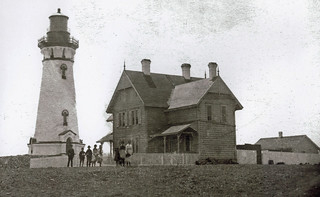
PIEDRAS BLANCAS LIGHT STATION

Piedras Blancas Light Station Outstanding Natural Area is part of the California Coastal National Monument. Located on a rugged windswept point of land six miles north of Hearst Castle along California's scenic Highway One, the Lighthouse was first illuminated in 1875 and today beckons the visitor for respite from the modern world.
The Light Station is named for the distinctive white rocks that loom just offshore. These rocks and the rugged shoreline are home to seabirds, sea lions and elephant seals. Over 70 native plant species can be found on the 19 acres surrounding the Light Station.
The BLM manages the Piedras Blancas Light Station as a historic park and wildlife sanctuary.
Access to Piedras Blancas is by guided tours only. Tours are offered year round, and feature cultural and natural history, as well as spectacular scenery.
Virtual Tour
Click on the titles and corresponding numbers below the map for interesting facts about the light station and 360 degree photos.

1. The Lighthouse
Click here to explore a 360 degree image from the top of the lighthouse.

that sat atop the lighthouse.
Lighthouse
Before dusk, the lighthouse keeper collected a supply of lard oil and climbed the over 100 steps to the top of the lighthouse. When at the top, the keeper cleaned the lens with cloth and animal furs, and made sure that the lens and rotating platform were operational. Then, the keeper lit the wick and tended to the lens all night to ensure the light was bright, focused and sent the correct signals to mariners.
2. Fog Signal Building and Fuel Oil Building
Click here to explore a 360 degree image of the buildings.
Fog Signal Building and Watchroom
The fog signal building served as an engine room for the various sound mechanisms that the lighthouse keepers used to communicate with mariners. The fog signal changed over the years, and each light station had a unique fog signal. The watch room served as a workshop and office for the keeper and also functioned as the main support building for maintaining the fog signal’s many mechanisms.
Fuel Oil Building
Constructed in 1909, the fuel oil building was used to store kerosene that powered the engines in the Fog Signal Building.
3. West Overlook
Standing at the windswept westernmost point of the light station, look out at the off shore rocks. Here, harbor seals bask on the lower rocks, while sea lions, Brandt’s cormorants, pelicans, and even peregrine falcons shelter on the largest of the rocks.

Photo courtesy of Gary O'Neil.
4. Whale Stop
Click here to explore a 360 degree image of the Whale Stop.
Whale Stop

Photo courtesy of Gary O'Neil.
A variety of whales migrate north and south past Piedras Blancas. Some species are seeking food, while others are just passing by on their journey. Though grey whales and humpback whales are the most commonly seen, it is not unusual to see blue whales, the largest animal ever to exist on the planet. Remember, these extraordinary animals are still mammals and must come to the surface of the water to breath air. Watch for the heart shaped spouts in the distance.
5. Otter Stop

Photo courtesy of Mike Barid.
6. Wharf and Elephant Seals
Click here to explore a 360 degree image of the former wharf and elephant seal beach.

Wharf
The wharf was as a delivery location for the United States Lighthouse Service to deliver fuel, building supplies and other necessities for the light station. The large ships that supplied the Pacific Coast lighthouses anchored off shore while smaller tenders brought the crates and barrels to the wharf.

Elephant Seals
Looking at the beach to the left, you will see elephant seals. Elephant seals occupy these beaches for weeks at a time during critical life experiences like birthing, mating or molting.
7. Historic District
Click here to explore a 360 degree image of the Historic District.
Historic District
The lighthouse keepers, their families and assistants lived together in a Victorian duplex. While the original house no longer stands, the footprint of the duplex can be seen across from the gift shop.
BLM Buildings/ Coast Guard Housing
Built in 1960 by the U.S. Coast Guard to replace to original Victorian duplex and Keeper’s Cottage, these are now used as office space and housing for interns and visiting wildlife researchers.

History
The site’s human history begins with native groups of Chumash and Salinan people harvesting sea life and other resources from the area. Later, the land came under a Mexican land grant and was managed as a rancho. Finally, in 1874, the land became a light station managed by the U.S. Lighthouse Service to serve as a navigational aid for sailors traveling along the coast.
Earthquakes over the years had caused damage to the lighthouse. An earthquake on the last day of 1948 resulted in the upper part of the Lighthouse being declared structurally unsound. In 1949, the upper three levels (fourth landing, watch room, and lantern) were removed.
With the advent of WW II, all light stations came under the management of the U.S. Coast Guard. As technology in maritime navigation improved, the light station became automated in 1975. Management was transitioned to the Bureau of Land Management in 2001.
In addition to still being a fully functioning automated light station, the unique wildlife and natural features of the point make Piedras Blancas a key research location for NOAA, USGS, FWS, and University of California researchers.

